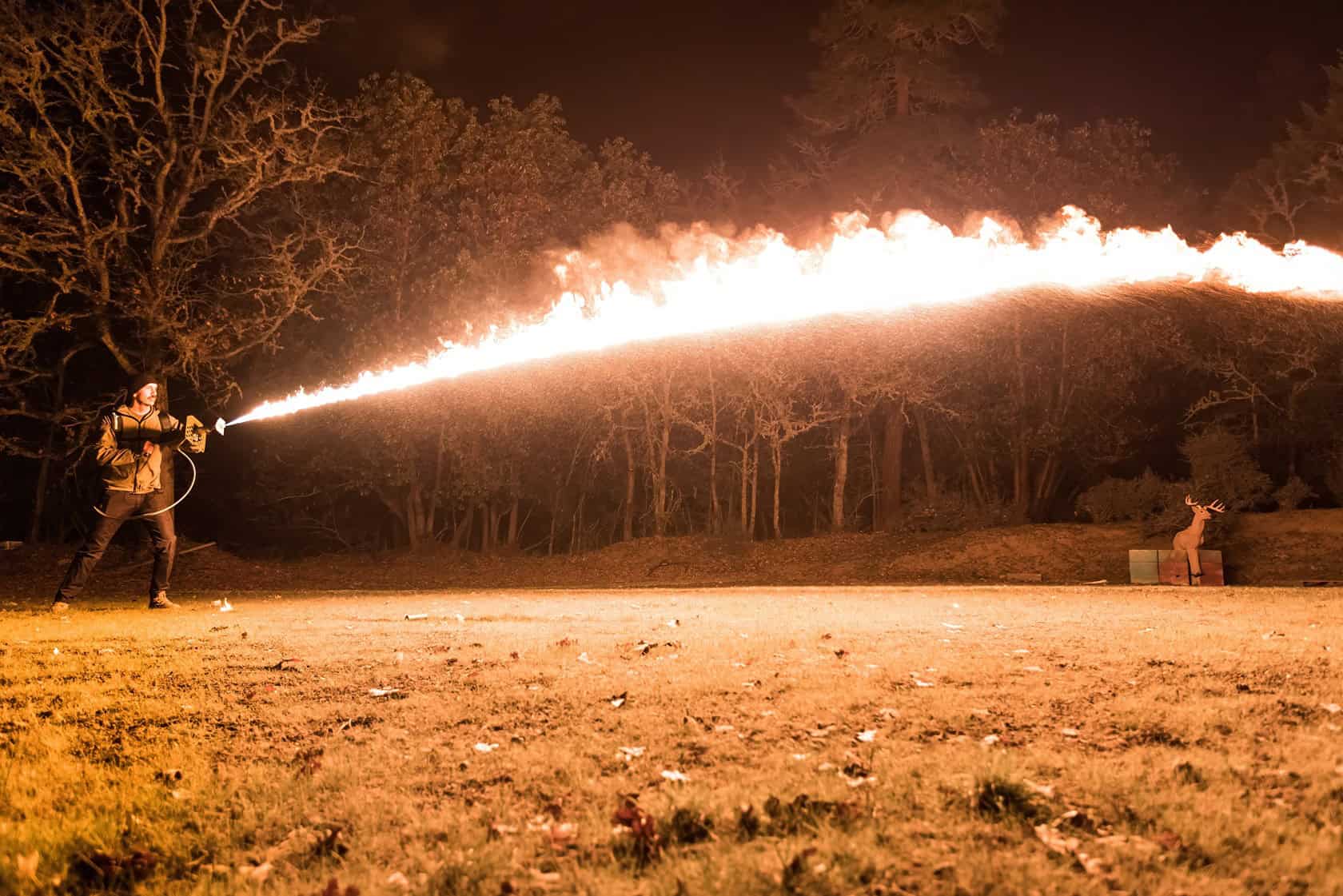Fire control just got a whole lot cooler with the Pulsefire flamethrower. This handheld device packs serious power with its arc ignition system and rechargeable lithium battery setup.
We’ll walk you through five essential facts about this compact flamethrower that’ll help you make a smart purchase decision. Ready to learn what makes this flame-throwing marvel worth your $509.99?
Key Takeaways
The Pulsefire Flamethrower costs $509.99 and runs on a 2200 mAh 3-cell lithium battery that powers 15 full tanks per charge.
At just 16 inches long and 6 pounds, this compact tool uses arc ignition technology instead of pilot lights for reliable flame production.
The device remains legal in most U.S. states except California and Maryland, with owners rating it 4.88 out of 5 stars for both practical and fun uses.
Regular maintenance includes weekly compressed air cleaning, monthly arc system checks, and keeping the 80 psi tank free from damage to prevent explosions.
The flamethrower works well for clearing brush, melting snow, and removing wasp nests, while also serving as entertainment for backyard target practice.
Table of Contents
Features of the Pulsefire Flamethrower
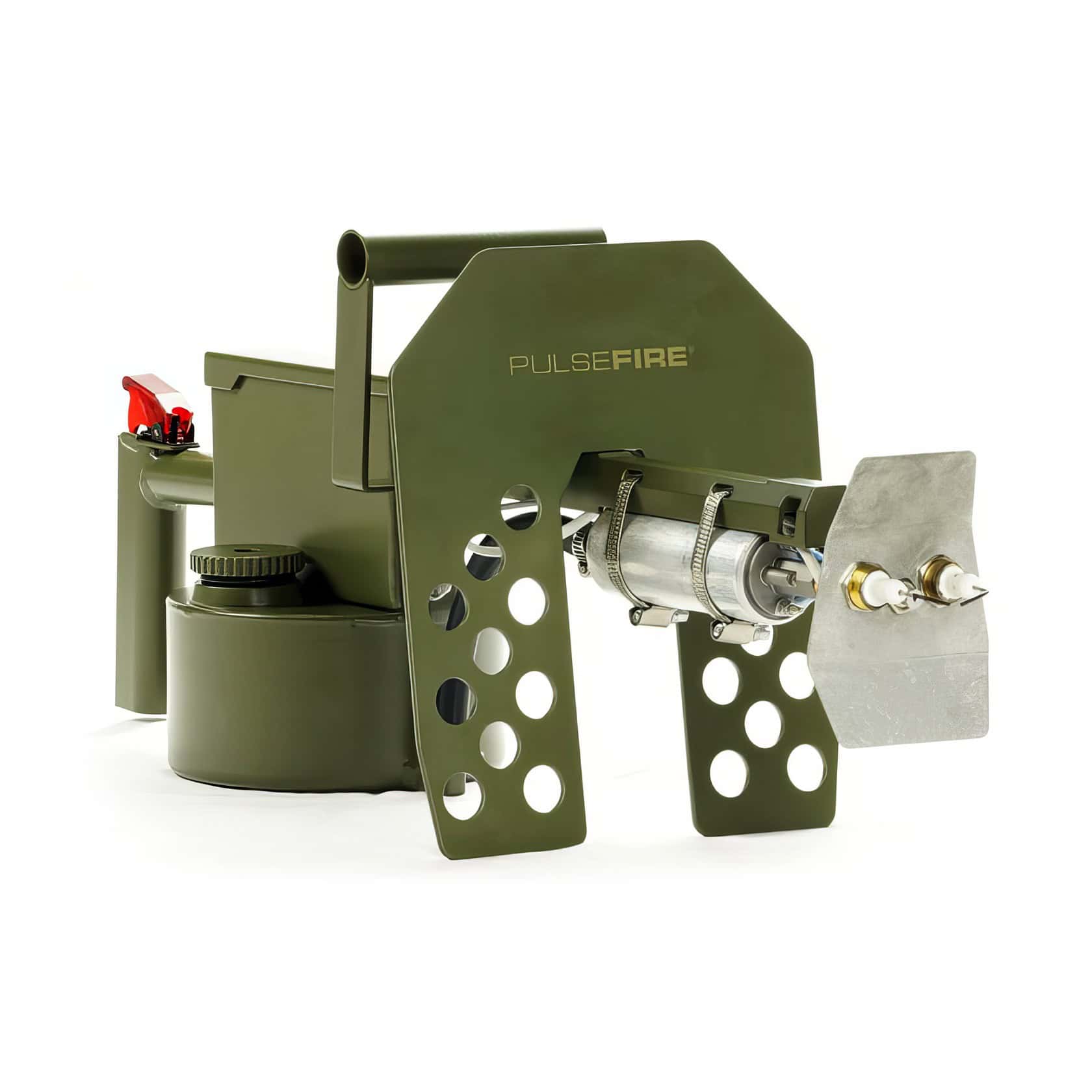
The Pulsefire Flamethrower packs serious power into a sleek, modern package. Its cutting-edge features make it stand out from other flame tools on the market, with smart tech that puts safety and performance first.
Arc ignition technology
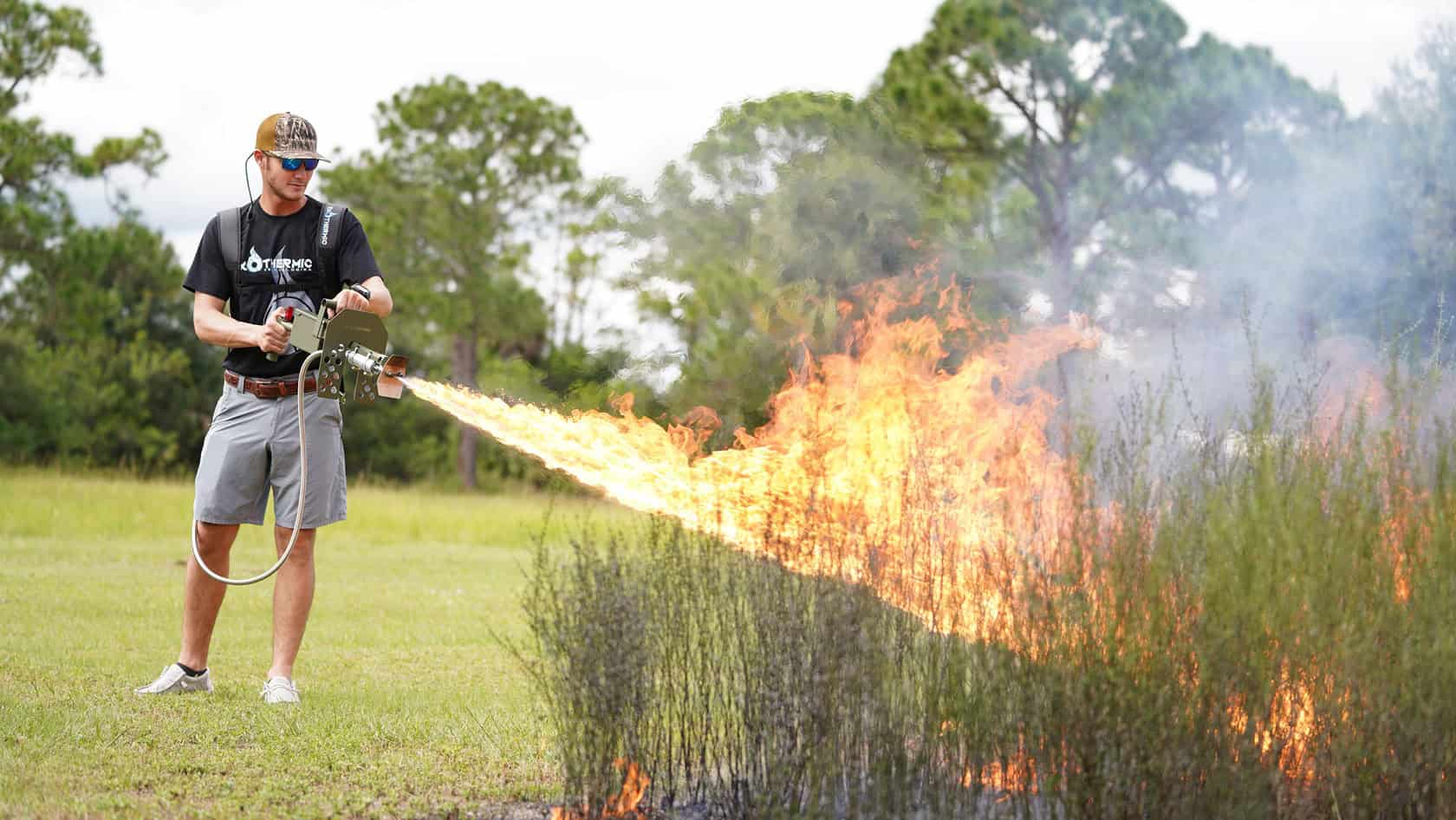
Arc ignition stands as a game-changer in modern flamethrower tech. Instead of old-school pilot lights, this system creates a non-stop electric spark that lights fuel instantly. High-frequency sparks jump between two electrodes, making sure your flame stays lit no matter what.
Electric arc ignition brings flamethrowers into the 21st century – Tech Enthusiast Magazine
Battery power drives this cutting-edge system, making it more reliable than traditional ignition methods. No more worrying about wind blowing out your pilot light or dealing with tricky manual ignition.
Speaking of power sources, let’s look at how battery-powered operation makes this tool even more impressive.
Battery-powered operation
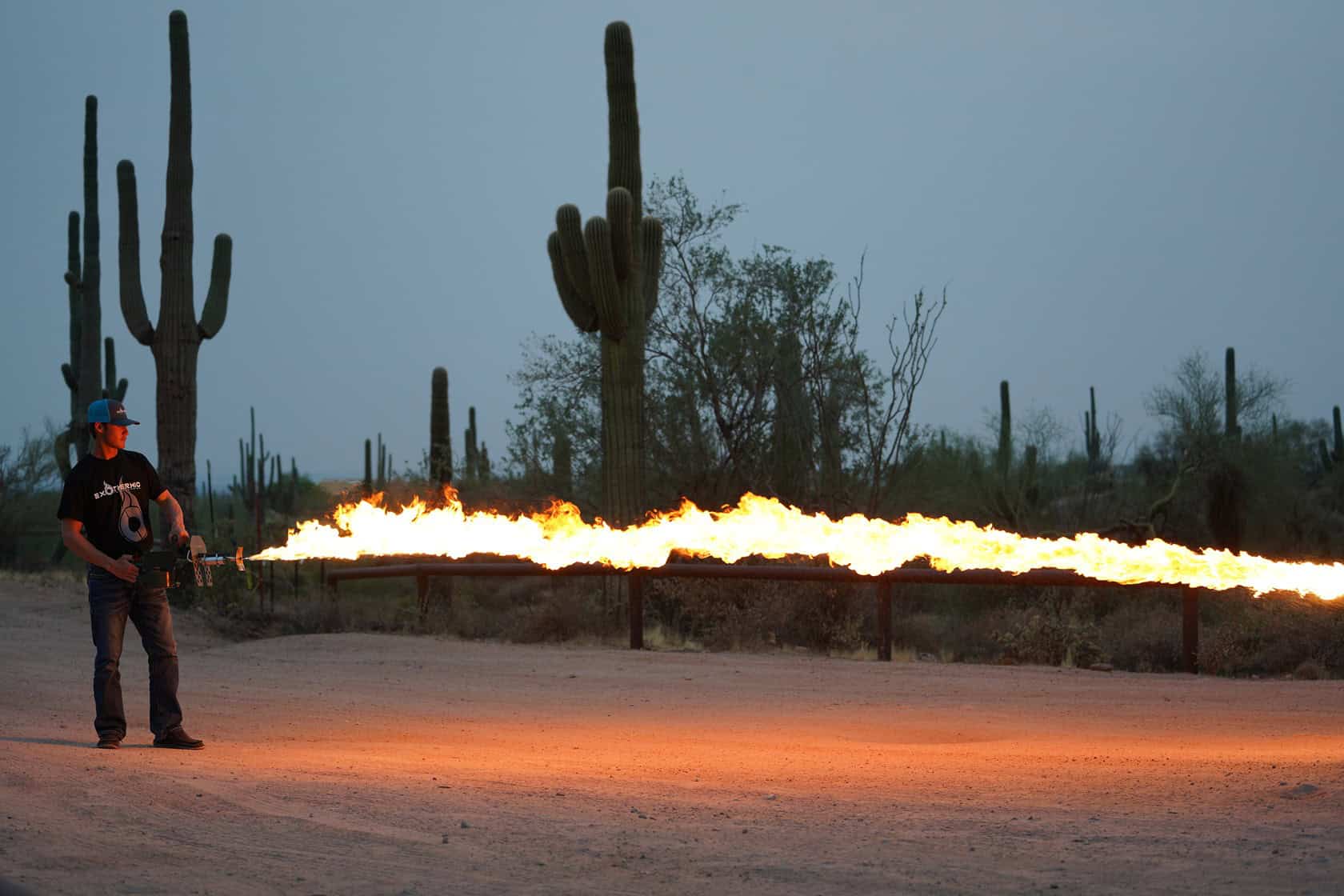
Moving beyond basic ignition systems, the Pulsefire flamethrower packs serious power in its battery setup. The device runs on a mighty 2200 mAh 3-cell lithium battery that keeps you firing longer.
This rechargeable powerhouse handles at least 15 full tanks of fuel before needing a charge.
The battery system makes this flamethrower stand out from older gas-powered models. You’ll get a complete charging kit right in the box – no extra shopping needed. The smart low-voltage cutoff feature stops the battery from draining too low, which helps it last longer.
Gone are the days of lugging around spare fuel cells or dealing with messy gas tanks. This modern approach to portable flame throwing puts more control in your hands with less hassle.
Lightweight and compact design
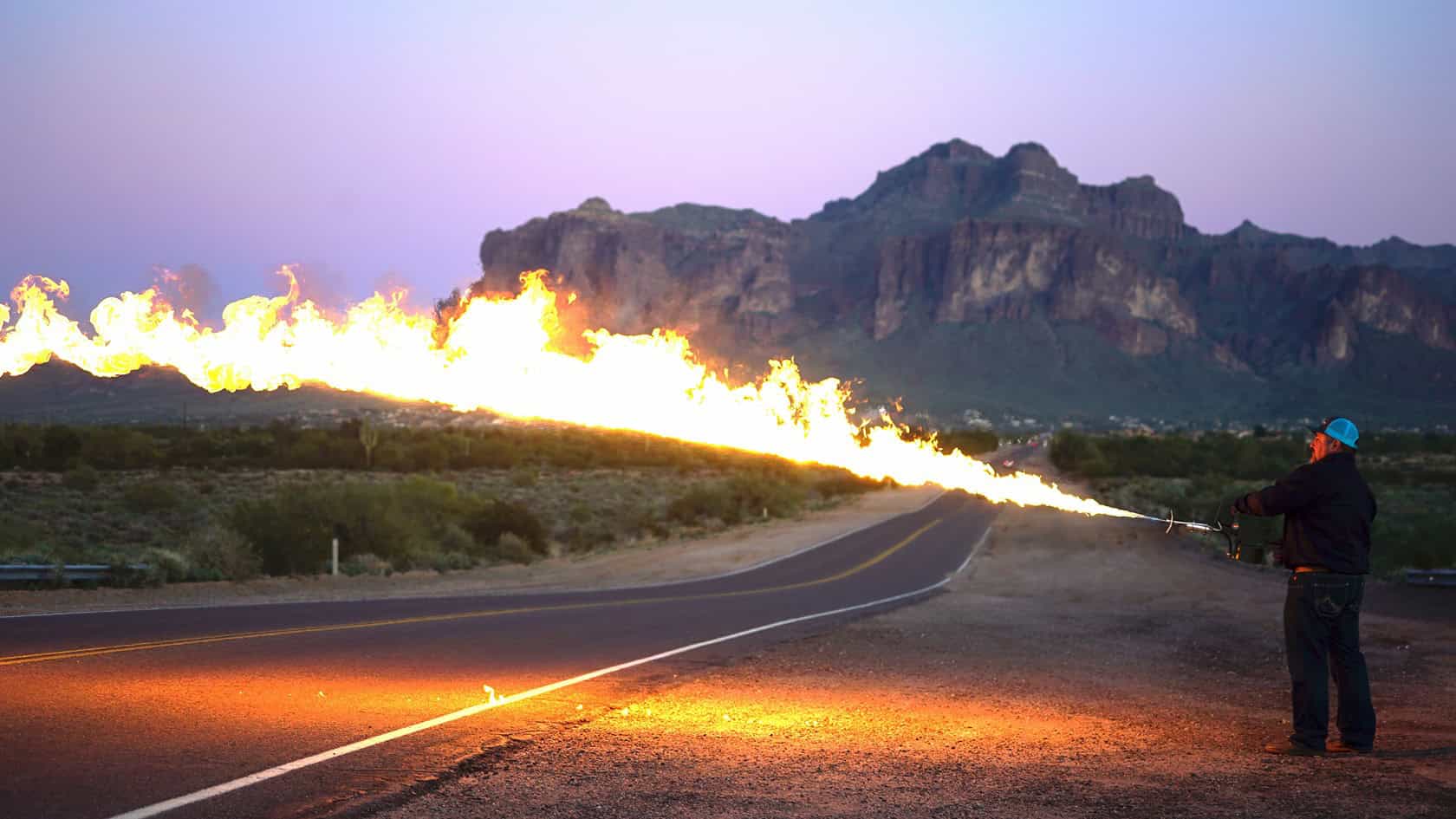
The battery system leads perfectly into another cool feature – this flamethrower packs serious power into a tiny package. At just 16 inches long and weighing 6 pounds, the Pulsefire fits right into a standard backpack.
The compact aluminum and brass build makes it super portable for outdoor activities.
The smart design keeps things simple yet effective. The 5-inch width and 9-inch height create a balanced grip that feels natural in your hands. Think of it as the handgun of flamethrowers – sleek, nimble, and ready for action.
The powder coat finish adds extra protection without extra bulk, making this tool perfect for both practical jobs and weekend fun.
Uses of the Pulsefire Flamethrower

The Pulsefire Flamethrower shines in both practical and fun applications. You can clear brush, melt snow, or zap pesky wasp nests with this battery-powered flame shooter.
Practical applications
Farmers and firefighters love this handheld flamethrower for its practical muscle. I recently used mine to clear thick brush on my property, and it worked like magic. This battery-powered tool mounts easily to picatinny rails or connects to a backpack kit for longer jobs.
U.S. Forestry Service members rely on it for controlled burns, while farmers use it to manage agricultural waste safely and quickly.
Snow and ice don’t stand a chance against this flame-throwing beast. Unlike directed energy weapons, this tool tackles real-world problems head-on.
From melting stubborn ice dams to removing pesky insect hives, its arc ignition technology makes quick work of tough tasks. My neighbor borrowed it last winter to clear his driveway after a nasty storm – he finished in half the usual time.
Recreational purposes
The Pulsefire Flamethrower brings pure joy to backyard fun and target practice. Many owners rate this device 4.88 out of 5 stars for its entertainment value alone. You can create amazing light shows in open spaces or practice your aim with this battery-powered marvel.
The lightweight design makes it perfect for extended play sessions without arm fatigue.
Just fun – Christopher C., August 2024
People love setting up safe shooting ranges with flame-resistant targets. The arc ignition technology lights up the night sky like Fourth of July fireworks. Some folks pair their flamethrower sessions with night vision gear for extra excitement.
The compact build fits nicely in most storage spaces, ready for the next outdoor party or target practice. Safety remains crucial during these recreational activities, so let’s explore the important legal guidelines you need to know.
Safety Tips and Legal Considerations
Safety rules matter with any flamethrower, and the Pulsefire needs special care like a Smith & Wesson handgun. You’ll need to check your local laws about owning one, just as you would for other gear like shotguns or airguns.
Are pulsefire flamethrowers legal?
Pulsefire flamethrowers stay legal in most U.S. states, except California and Maryland. You can’t ship these flame-spitting tools to Alaska, Hawaii, or Puerto Rico either. The rules match those of many ar-15 and handgun regulations, making ownership straightforward in places like Colorado, where they’re 100% legal.
Most states treat flamethrowers like regular tools rather than weapons. Think of them like powerful drill bits or airguns – they need careful handling but don’t face strict control.
I grabbed mine last summer with just a credit card and basic ID check, similar to buying a Mossberg shotgun at your local store. The checkout process felt as simple as picking up any other piece of outdoor equipment.
Can a flamethrower explode?
Legal concerns lead us straight into safety risks. The short answer is yes – flamethrowers can explode under certain conditions.
Safety isn’t just a feature, it’s the foundation of responsible ownership.
The biggest risk comes from the pressurized tank running at 80 psi. Poor design or damage to key parts like barrels and muzzle devices can cause dangerous failures. I’ve seen firsthand how structural weak points in cheap flamethrowers create major hazards.
The tank’s integrity matters most – any cracks or dents spell trouble. Smart owners check their gear before each use, just like maintaining a rifle scope or laser sight. Proper storage keeps the pressure system stable and prevents accidents.
Regular inspection of all parts, especially around the primer and ignition areas, helps spot problems early.
Maintenance and Care
A clean flamethrower works better and lasts longer, just like your favorite rifle or handgun. Your Pulsefire needs regular checks and proper storage to keep its arc ignition system running smooth, plus you’ll want to keep those batteries fresh and charged.
Regular cleaning and inspection procedures
Keeping your Pulsefire Flamethrower clean makes it work better and last longer. Safety starts with proper maintenance, just like any other tool in your arsenal.
- Spray compressed air through all vents and ports to remove dust particles – do this weekly for best results
- Clean the battery contacts with a soft brush and isopropyl alcohol to maintain strong power flow
- Check the arc ignition system monthly using a multimeter to test voltage output
- Inspect all O-rings and seals for cracks or wear during each cleaning session
- Remove carbon buildup from the nozzle tip using a brass brush after every use
- Test the trigger mechanism’s responsiveness by dry-firing without fuel loaded
- Document each cleaning session in a maintenance log with date and specific tasks done
- Look for loose screws or mounting hardware – tighten them with proper torque specs
- Clean the fuel tank with manufacturer-approved solutions every 3 months
- Run a full system diagnostic check annually, just like you would with your favorite rifle scope
Next up, we’ll explore the best storage practices to keep your flamethrower ready for action.
Proper storage guidelines
Storing your Pulsefire flamethrower takes more than just tossing it in a closet. Safe storage protects both your device and everyone around you.
- Store in a cool, dry place away from direct sunlight, like a locked gun safe or secure cabinet
- Empty all fuel from the tank before long-term storage to prevent pressure buildup
- Place the flamethrower in a horizontal position on a flat surface to maintain proper balance
- Lock the safety switch in the “off” position during storage periods
- Keep the arc ignition system clean and free from debris using compressed air
- Use a moisture-absorbing silica gel packet near the storage area to prevent rust
- Cover the device with a breathable cloth to keep dust away while allowing airflow
- Label your storage area with clear warning signs to alert others
- Check pressure gauges monthly for any signs of leaks or system issues
- Place the battery charger in a separate, dry location away from flammable materials
- Maintain a minimum 10-foot distance from other stored weapons or ammunition
- Document your maintenance schedule and last inspection date on a nearby log sheet
- Install a fire extinguisher within easy reach of your storage area
Troubleshooting common issues
Fixing your Pulsefire Flamethrower doesn’t need to be rocket science. Most issues have simple fixes that you can handle right at home with basic tools.
- Weak flame output often means your battery needs charging or replacing. The lithium-polymer batteries last about 200 cycles or two years, just like your favorite handgun’s red dot sight.
- Short flame streams pop up from wind or blocked nozzles. Clean the nozzle with compressed air, similar to cleaning your rifle scopes.
- Strange noises during operation signal loose parts. Tighten all screws and check seals, much like maintaining your break action firearms.
- Ignition failure happens if the arc ignition system gets dirty. Clean the electrodes with alcohol wipes, like you’d clean your iron sights.
- Fuel leaks need immediate attention. Check all connections and replace worn seals – basic maintenance similar to checking your magazines.
- Battery charging problems show up as slow charging or no charge hold. Replace the battery if it won’t hold a charge after several attempts.
- Uneven flame patterns mean clogged fuel lines. Flush the system with approved cleaner, just as you’d clean your lever action rifle.
- Control switch issues need quick fixes. Clean the contacts with electronic cleaner spray for smooth operation.
- Pressure problems show as weak sprays. Check the pump system and clear any blockages in the fuel path.
People Also Ask
Is the Pulsefire Flamethrower similar to other lightweight flamethrowers?
No, it’s quite different from your typical flame thrower. While it shares some features with handguns and revolvers, this battery powered device brings more punch than a Glock or Ruger.
What mounting options does the Pulsefire offer?
The Pulsefire works with mil-std-1913 rails, much like those used for laser sights and holographic sights on AR-10s. You won’t need shoulder holsters or ankle holsters for this one!
How does reloading work on the Pulsefire?
Unlike pump action or lever action rifles that need special reloading dies, the Pulsefire has a simple reload system. It’s easier to handle than loading an AK-47 or Type 56.
What safety features come with the Pulsefire?
The Pulsefire packs safety features similar to those found on snubnose revolvers and the AK-74. Each unit comes with a receipt and clear safety guages for proper operation.
Can I add extras to my Pulsefire?
Yes! Like the AK-101 and Krinkov, the Pulsefire accepts add-ons. You can mount LPVO scopes and other reamers to boost your experience, though some limits apply.
